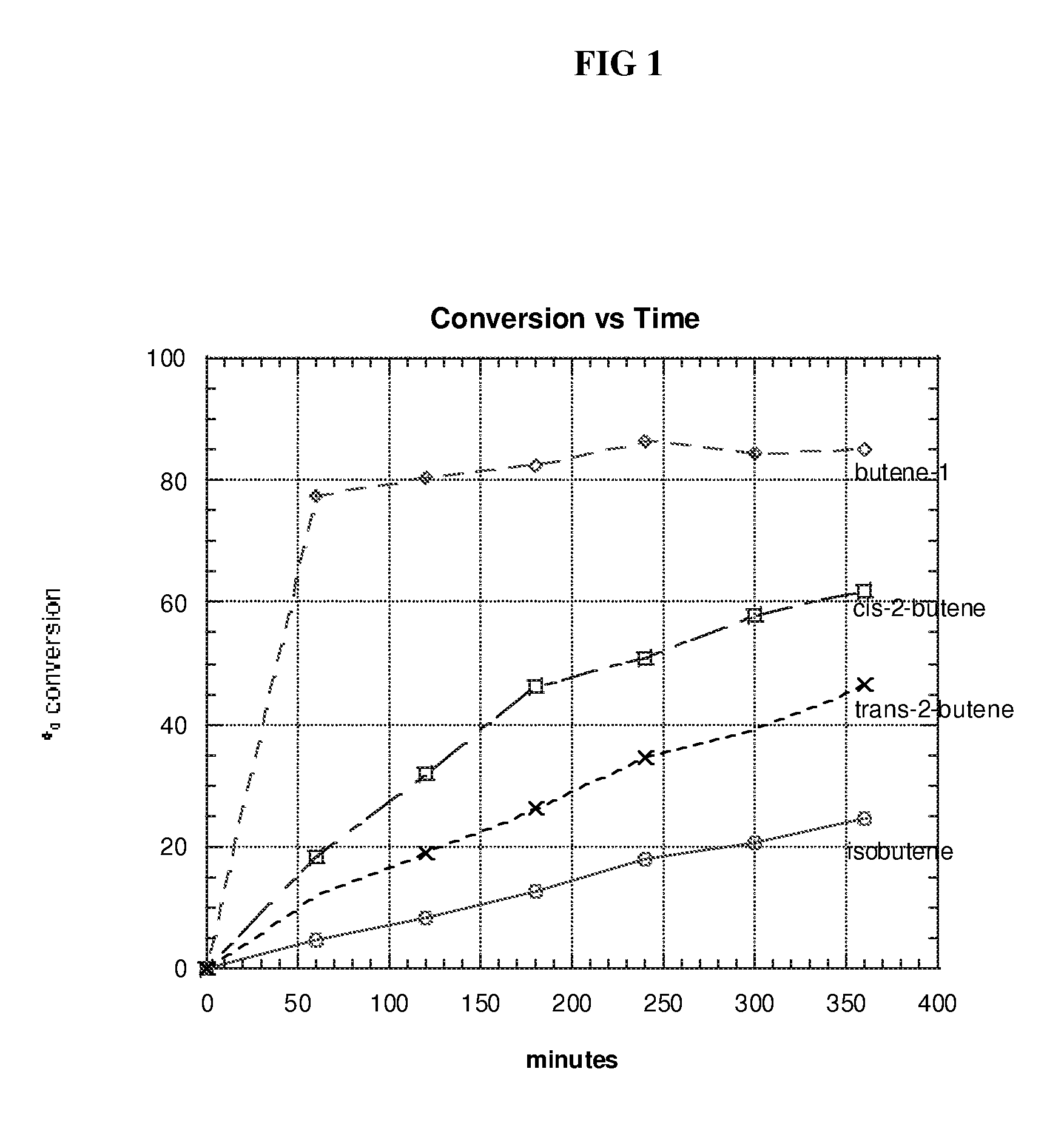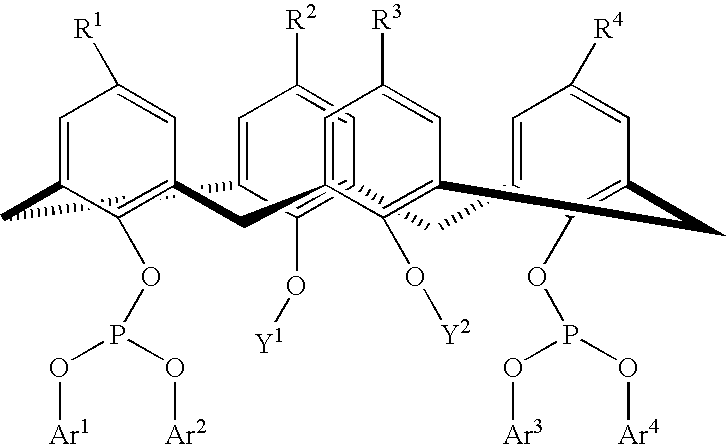Calixarene bisphosphite ligand for use in hydroformylation processes
a technology of calixarene and bisphosphite, which is applied in the direction of physical/chemical process catalysts, organic compounds/hydrides/coordination complex catalysts, etc., can solve the problems of difficult and expensive procedures for removing one isomer from an isomeric, difficult and expensive procedures for removing isobutene from a c4 raffinate, etc., to achieve a higher n:i product isomer ratio and the effect of terminal
- Summary
- Abstract
- Description
- Claims
- Application Information
AI Technical Summary
Benefits of technology
Problems solved by technology
Method used
Image
Examples
example 1
(a) Synthesis of 2,2′-biphenyl phosphoromonochloridite
[0058]2,2′-Biphenol (362.5 g, 1.908 mol) is charged to a 2-liter flask under a nitrogen gas atmosphere. Phosphorous trichloride (990.0 g, 7.21 mol) is added to the flask at room temperature, and the resulting mixture is heated slowly to reflux. A vigorous evolution of hydrogen chloride gas is observed at 38° C. Gas continues to evolve up to a temperature of 83.5° C. The mixture is then vacuum distilled, yielding 2,2′-biphenyl phosphoromonochloridite as an off-white solid (373.6 g, 1.49 mol; 78% yield). Analysis: 31P {1H) NMR (CDCl3, 121.66 MHz) σ (PPM) 180.00.
(b) Synthesis of 2-bromo-N,N-diethylacetamide
[0059]Under a nitrogen atmosphere, a 1-liter flask is charged with 2-bromoacetylbromide (46.34 g, 230 mmol) and 300 ml ether. The flask is chilled to −15° C., and a solution of diethylamine (33.72 g, 460 mmol) in 200 ml ether is added over 1 hour to the flask. The resulting thick slurry is stirred cold for 1 additional hour, then ...
example 2
[0063]The following procedure is conducted to measure the conversion of the individual isomers of butene in a hydroformylation process using a catalyst comprising rhodium and the calixarene bisphosphite ligand prepared in Example 1(d). Since butene-1 isomerizes to butene-2 and vice versa, accurate conversions of butene-1 and butene-2 are difficult to measure on an isomeric mixture. Accordingly, the conversions are more accurately measured on the hydroformylation of the individual isomers.
[0064]A rhodium catalyst precursor (dicarbonylacetylacetonato rhodium (I), 0.034 g, 300 ppm) and the N,N-diethylacetamide-p-tert-butylcalix[4]arene bisphosphite ligand of Example 1(d) (0.342 g, 2 equivalents / Rh) are weighed into a septum-capped bottle in a dry box. The solids are dissolved in tetraglyme, and the resulting solution transferred via vacuum into a 100 ml Parr mini-reactor. The catalyst-containing solution is then preheated with agitation (1100 rpm) to 85° C. under 1:1 carbon monoxide:hy...
example 3
[0065]A hydroformylation of a butene raffinate stream is conducted as follows. A rhodium catalyst precursor (dicarbonylacetylacetonato) rhodium (I) (0.034 g, 300 ppm) and N,N-diethylacetamide-p-tert-butylcalix[4]arene bisphosphite ligand prepared in Example 1(d) (0.342 g, 2 eq / Rh) are weighed into a septum-capped bottle in a dry box. The solids are dissolved in tetraglyme (40.0 ml) to form a catalyst precursor solution. The precursor solution is transferred under vacuum into a 100 ml Parr mini-reactor. The solution is then preheated with agitation (1100 rpm) to a desired reaction temperature under 1:1 volume ratio of gaseous H2:CO (syn gas) for 20-30 minutes. A C4 raffinate feedstream, obtainable from Shell Oil Company and having the composition shown in Table 2, is fed in liquid form (4.7 g) to an isolated section above the reactor and fed under pressure with syngas into the reactor.
TABLE 2Composition of Raffinate FeedRaffinate 1 FeedCompositionMethane, mol %0.01C2's, mol %0.01Prop...
PUM
| Property | Measurement | Unit |
|---|---|---|
| Temperature | aaaaa | aaaaa |
| Temperature | aaaaa | aaaaa |
| Fraction | aaaaa | aaaaa |
Abstract
Description
Claims
Application Information
 Login to View More
Login to View More - R&D
- Intellectual Property
- Life Sciences
- Materials
- Tech Scout
- Unparalleled Data Quality
- Higher Quality Content
- 60% Fewer Hallucinations
Browse by: Latest US Patents, China's latest patents, Technical Efficacy Thesaurus, Application Domain, Technology Topic, Popular Technical Reports.
© 2025 PatSnap. All rights reserved.Legal|Privacy policy|Modern Slavery Act Transparency Statement|Sitemap|About US| Contact US: help@patsnap.com



